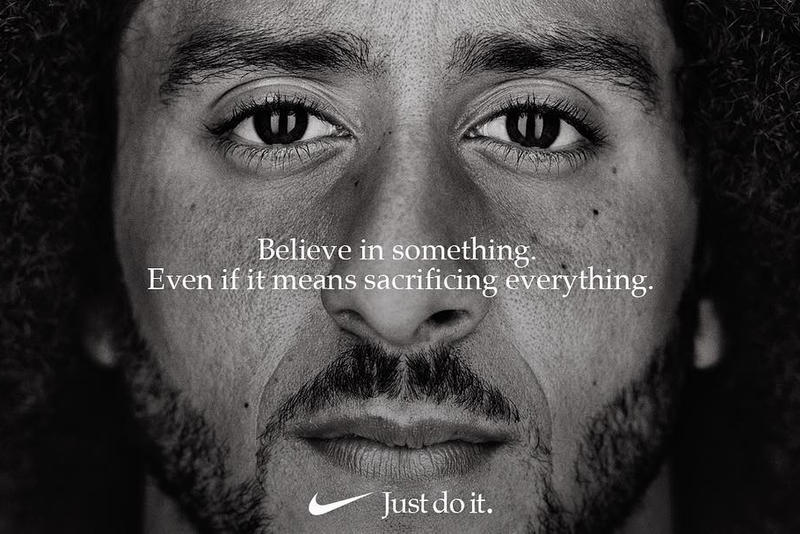Nike tribal strategy went planetary once again. They needed it and the made it.
Nike masters the tribal strategy. They obviously understood how the communication works efficiently at the end of this decade. First a brand needs to build a loyal tribe and second, this tribe must have an appealing ideology. Therefore it will attract organically new members by being diligent and spreading the news.
But the brand needs to be edgy and courageous enough to create antagonism. “Us versus them”. “The believers vs. non-believers”. Without anything at stake, nobody would really care. In the 5 seconds attention span of social media, without proper sharpness, the message will just fly by.
#Nike #ColinKaepernick campaign:
1. Tribal strategy
Creating a tribe always starts with “this is what we believe in”. The tribe’ scope always represent a meaningful ideal for the group, and will be completed by showing the proper ways to achieve the dream. The tribe lives and dies through its heroes that all follow a certain archetype (e.g. they are idealists or rebels, caregivers, gurus, and so on). The idols have the role to inspire and guide the believers (the followers) towards respecting the same ideal.
At the end, to consolidate its scope, the entire tribe has to measure its success by earning something or defeating somebody. That’s why, if you do not have a clear thing to win, a powerful tribe needs a powerful enemy or an antagonist, to give a sense of urgency, and make the heroes and their scope even stronger.
The tribal scope, values, its archetypal heroes, their success and their believers, as opposed to the vilified enemies, are the main driving forces for a successful tribal ideology. Deciding which levers to push to unite the tribe can be called the brand tribal strategy.
2. The tribal resurrection.
Manifestos exists in marketing since forever. They have the scope to unite the tribe and give a certain direction. Many brands tried before. Some did it super successful and became benchmark (Apple in 1986 and 1994), others recently failed (Pepsi). What made the real difference?
Success relates to the appeal of the proposed ideology. Second, it really matters if the brand has the relevance and credibility to sustain it by walking the talk.
In the Apple 1994 campaign, the scope was related to creativity and progress. It glorified the archetype of the rebel, seen from its impact perspective: “They have got things differently, because they do not follow the rules. You can love them or vilify them, but you cannot ignore them, because they changed the world”. It was elegant and sustained by the brand positioning as the single Microsoft/ PC alternative. People loved the campaign and it worked brilliantly.
#Apple #ThinkDifferent:
In the Pepsi Kendall Jenner campaign, it was no ideology or hero archetype. It was just an average ad that brings people together. The brand produced a product placement while piggybacking on a pop-star charisma and on a recent social tensions. It was unsophisticated and without a mean. People hated the campaign and it failed miserably.
Nike is smart enough to learn from both Apple success and Pepsi fiasco. In many aspects, the Nike manifesto is not far away from Apple 1994. To note, it follows the same rebel archetype of being unique, defeating the odds and being crazy enough to believe in your dreams. Nike also has the equity power and credibility to sustain the message.
3. So why are people burning up Nike shoes?
The are some notable differences between Nike, Apple or Pepsi, by pushing different buttons.
In Apple case, it insisted on the heroes and their success: benefits for humankind. The enemy was just complaisance of the status quo. It has a positive and optimistic tone of voice. Nobody could argue with and everybody loved the idea.
In the negative Pepsi instance, the brand had no credibility, it just surfed commercially on some trending ideals. It managed to annoy the existing believers.
From Nike perspective, the brand has credibility and the ideal is proper: be crazy enough and dream big. So what really happened? Nike basically achieved what powerful ideologies do. It has high impact, but polarize with intention.
“Us vs. them”. “Believers vs. non-believers”. It makes people antagonise. In the Nike tribal strategy, they purposely chose a hero (Colin Kaepernick) that has a clear scope (hidden in this ad) and powerful enemies. Even is not explicitly, the hero’s scope and its opponents are the ones who define the real Nike ideology, which lies concealed in the background. Is not about sport, creativity, work or defying the odds. Is about standing up against social injustice.
Nike is brave, but actively cutting people’s hearts and polarising by purpose.
4. Critique: are there real differences between brand manifestos and propaganda?
Manifestos represents a cliché irony. They use stardust and crowd effect to empower people fantasy, create the uniform of individuality, the peer pressure to be free. Philosophically they are oxymorons.
The second paradox is the fact that manifestos use the same patterns as propaganda. They are highly emotional, avoid rational rules, highlight an enemy and hide the propagandist true scope*. As a rule, propaganda appeals only to emotional part of our brain. They do not offer any facts or figures. It is just us versus them.
The same weapons are used for a different propagandist scope, with impact on different tribes, that believe in different ideals. They are not better, but different.
Nike is going to be remembered as a benchmark of courage. But do not get things wrongly. At this level, everything is carefully measured and assumed, including the effects of the campaign on key target groups.
The Nike campaign constitutes a representative scan of the current and future society. Nike knows the demographic trends and they ensure that the next generations will resonate to the background ideology. They will lose maybe something today, but will gain the tomorrow most important target groups. As a start, they amassed 43 Million $ in free publicity in the first 24 hours. Up to the end of the campaign, probably this will be multiplied by a factor of 20 or 30.
“Whenever a brand attaches its logo to someone else’s face, they are making a calculated cost benefit analysis that is something that has been core to Nike’s DNA”: Link.
*the propagandist true scope is just to boost sales on long run, but needs to be properly hidden among strong values and powerful emotions.

